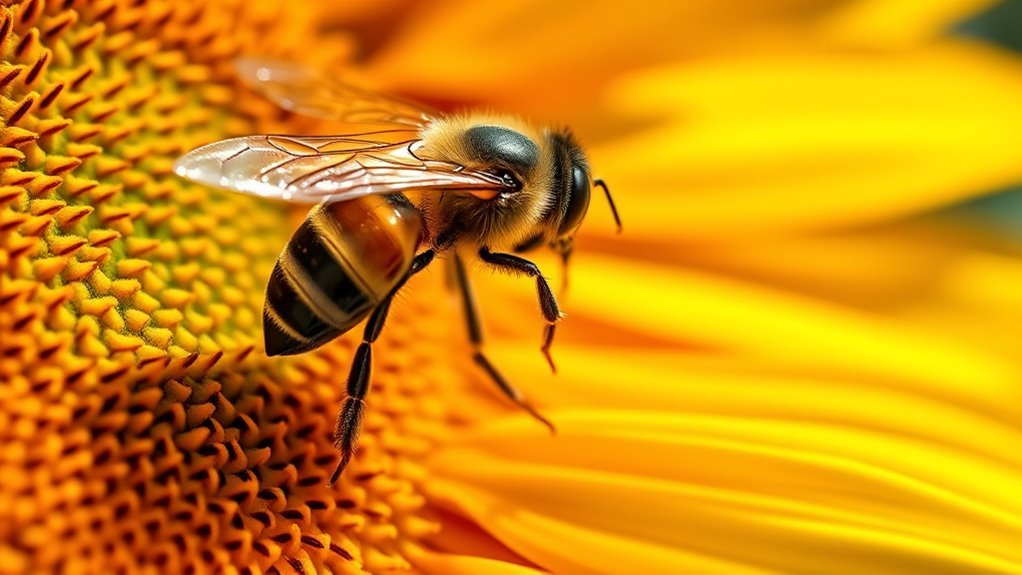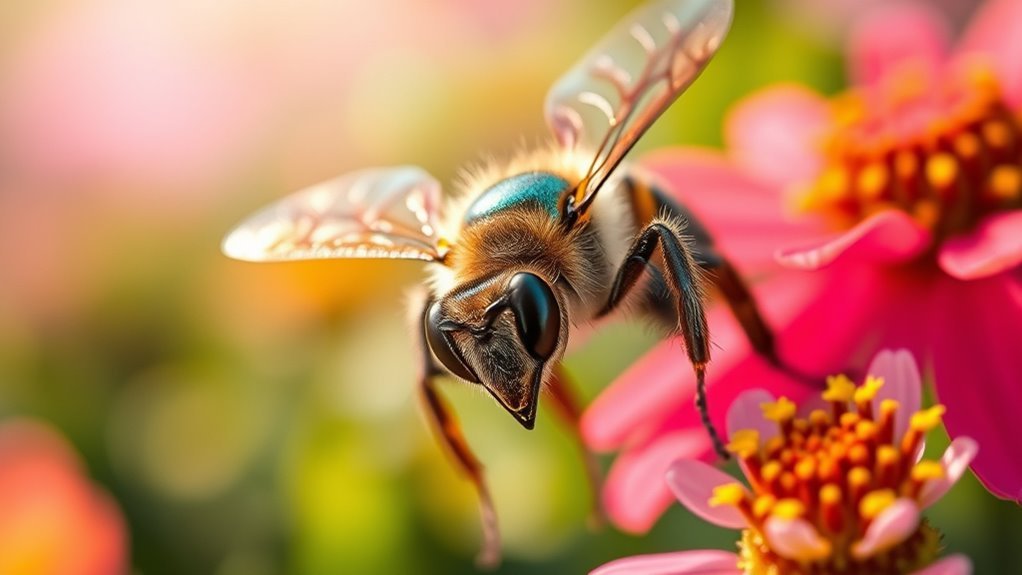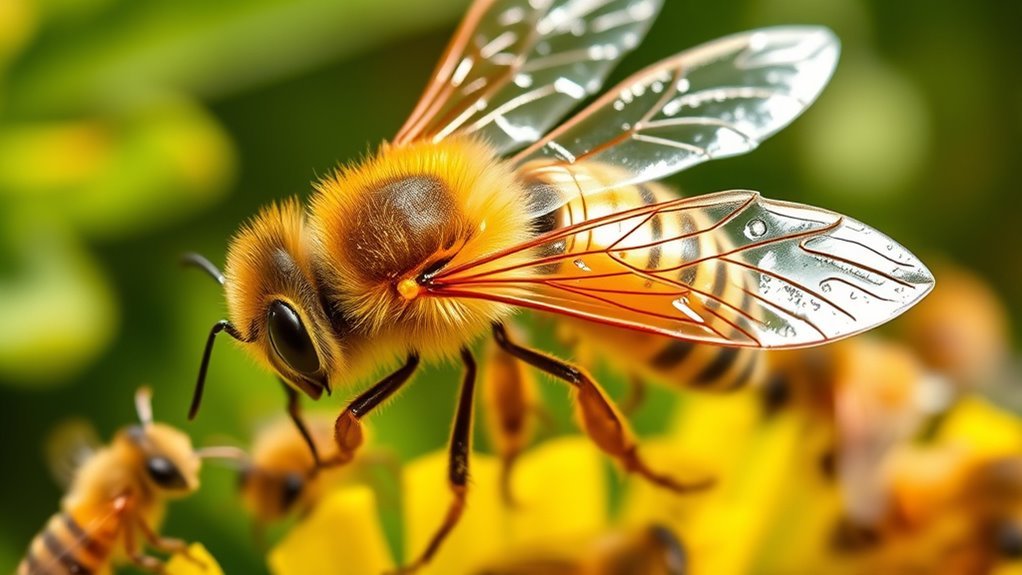Bee drones are essential for hive reproduction, maturing from unfertilized eggs in about 24 days. They have larger bodies, no stingers, and lack pollen baskets, focusing solely on mating. Drones participate in seasonal mating flights to guarantee genetic diversity, with peak production in spring and summer. Their roles are distinct from worker bees, who manage foraging and hive maintenance. By understanding the unique behaviors and challenges faced by drones, you can appreciate their important function in beekeeping.
The Life Cycle of Bee Drones

The life cycle of bee drones is a fascinating process that highlights their unique role within the hive. Drones develop from unfertilized eggs, a critical aspect of their reproductive cycles. It typically takes about 24 days for a drone to mature, starting from egg to larva and then pupating. During drone development, they receive specific nutrition, primarily royal jelly, which influences their growth. Once matured, drones leave the hive to participate in mating flights, where they seek out virgin queens. This mating process is essential for genetic diversity within the colony. After mating, drones typically die, underscoring their singular purpose. Understanding this cycle not only reveals the intricacies of bee society but also emphasizes the delicate balance of their reproductive strategies.
Physical Characteristics of Drones

Drones, the male counterparts in a bee colony, exhibit distinct physical characteristics that set them apart from worker bees and queens. Their drone anatomy includes larger, robust bodies, typically measuring about 15 mm in length, making them bulkier than their female counterparts. Unlike workers, drones possess no stingers, reflecting their specialized role in reproduction. Their large, compound eyes are essential for locating queens during mating flights, enhancing their reproductive traits. Additionally, drones have broader wings, contributing to their agility in the air. The absence of certain worker bee features, like pollen baskets, emphasizes their singular purpose: mating. Understanding these characteristics is vital for appreciating the unique role drones play in the hive’s reproductive cycle.
The Role of Drones in the Hive

In a bee colony, drones fulfill a critical role primarily centered around reproduction. Unlike worker bees, drones don’t participate in foraging or hive maintenance; their existence mainly supports the hive’s reproductive needs. In the hive hierarchy, drones are often at the bottom, relying on workers for sustenance and care. Effective drone communication is crucial, as it helps coordinate their presence during mating flights and signals readiness for reproduction. While they don’t contribute directly to the hive’s daily functions, their role is essential for genetic diversity and hive survival. Drones are expelled from the colony in late autumn, showcasing the hive’s focus on efficiency, emphasizing their transient role in the grand scheme of the colony’s life cycle.
Mating Behavior and Strategies
While mating behaviors of drones may seem simplistic, they are actually complex strategies that guarantee successful reproduction within the hive. Drones participate in mating flights, where they congregate in specific areas known as drone congregation areas. This is where drone competition for queen selection intensifies. The strongest and most genetically diverse drones often have the best chances to mate with a queen, ensuring the hive’s genetic viability. During these flights, drones utilize pheromones to attract queens and signal readiness. The mating process is brief but critical; successful drones will mate mid-air, transferring sperm that will fertilize the queen’s eggs. Understanding these mating strategies can help beekeepers appreciate the intricacies of drone behavior and their role in hive health.
Seasonal Patterns and Drone Production
The dynamics of drone production are closely linked to seasonal changes, reflecting the hive’s reproductive strategy. During spring and summer, as floral resources peak, you’ll notice an increase in drone production, aligning with the hive’s need to mate and guarantee genetic diversity. As the seasons shift to fall, drone production declines considerably, signaling the end of mating season and resource allocation for winter survival.
| Season | Drone Production | Hive Activity |
|---|---|---|
| Spring | High | Foraging & Mating |
| Summer | Moderate | Brood Rearing |
| Fall | Low | Preparing for Winter |
| Winter | None | Hive Maintenance |
Understanding these seasonal cycles helps you appreciate the intricate planning behind drone production in bee populations.
The Importance of Genetic Diversity
Genetic diversity in bee drones is essential for maintaining colony health and resilience. It enhances the overall fitness of the population, allowing for better adaptation to environmental changes and threats. By understanding these benefits, you can appreciate the role of genetic variation in sustaining healthy bee populations.
Benefits of Genetic Variation
Although many might overlook it, genetic variation plays a crucial role in the health and resilience of bee populations, particularly drone bees. This genetic diversity fosters adaptability, equipping colonies to withstand environmental changes and diseases.
- Increased genetic resilience: A diverse gene pool enhances a colony’s ability to recover from stressors.
- Evolutionary advantages: Variability can lead to traits that improve survival rates, giving certain drones an edge in reproduction.
- Enhanced foraging efficiency: Diverse genetics can result in varied foraging behaviors, optimizing resource acquisition.
Impact on Colony Health
While it might seem subtle, the impact of genetic diversity on colony health is profound and multifaceted. A diverse gene pool enhances drone health, which in turn stabilizes colony dynamics. When drones possess varied genetic traits, they can better adapt to challenges such as disease resistance and environmental stressors. This diversity guarantees that colonies remain resilient and productive.
Here’s a table summarizing the impact of genetic diversity on colony health:
| Aspect | Importance | Impact on Colony Dynamics |
|---|---|---|
| Disease Resistance | Higher genetic variation increases immunity | Reduces mortality rates |
| Foraging Efficiency | Diverse traits improve foraging success | Increases food availability |
| Reproductive Success | Genetic variation enhances mating opportunities | Promotes colony growth |
| Adaptability | Diverse genes enable adaptation to stress | Guarantees long-term viability |
| Colony Stability | Genetic diversity supports overall health | Maintains colony productivity |
Adaptation to Environmental Changes
The ability of bee drones to adapt to environmental changes hinges considerably on the diversity within their genetic makeup. Genetic variation is essential for climate adaptation and enhances the resilience of bee populations. When drones possess varied genes, they can better withstand stressors like temperature fluctuations, pesticide exposure, and habitat loss.
- Increased genetic diversity promotes environmental resilience.
- Diverse gene pools allow colonies to adapt to new challenges.
- Genetic variation can lead to improved foraging and reproductive success.
Challenges Faced by Bee Drones
As you explore the world of bee drones, you’ll quickly realize that these vital members of the hive face several significant challenges. One primary issue is mating challenges; drones must locate queens during limited windows of opportunity, often competing against numerous others. Environmental threats exacerbate this situation; habitat loss, pesticide exposure, and climate change disrupt their natural behaviors and mating patterns. Additionally, changing weather conditions can affect the timing of floral availability, impacting food sources. Drones also face higher mortality rates due to their singular focus on reproduction, often resulting in death shortly after mating. Understanding these challenges is important for anyone interested in supporting bee populations and ensuring their ecological role remains intact.
Drones vs. Worker Bees: Key Differences
When comparing drones and worker bees, it is crucial to examine their distinct roles within the colony and their physical characteristics. Drones primarily exist to mate with a queen, while worker bees perform various tasks, including foraging and hive maintenance. Additionally, you’ll notice significant differences in size and body structure that reflect their specialized functions.
Role in Colony
Drones and worker bees serve distinct yet essential roles within a bee colony, highlighting the intricate division of labor that guarantees survival and productivity. Drones’ primary function is to mate with the queen, ensuring genetic diversity, while worker bees handle foraging, hive maintenance, and defense. Their contributions reflect a clear colony hierarchy, where each caste has specific duties.
- Drones communicate through pheromones, signaling their readiness to mate.
- Worker bees maintain hive structure and regulate temperature, critical for brood development.
- The balance of roles between drones and workers fosters a thriving colony ecosystem.
Understanding these roles can deepen your appreciation for the complex social dynamics within the hive. Each bee plays a fundamental part, ensuring the colony’s overall health and functionality.
Physical Characteristics
The physical characteristics of drones and worker bees reflect their specialized roles within the colony. Drones, or male bees, have distinct drone anatomy that sets them apart from workers. They possess larger bodies and rounder abdomens, which facilitate mating. In contrast, worker bees are smaller, with elongated abdomens that allow them to perform various tasks, including foraging and hive maintenance. Drone coloration also differs; they tend to have a more robust, often darker appearance compared to the lighter, more slender workers. This differentiation in size and color not only aids in identification but also signifies their unique functions, with drones primarily focused on reproduction, while workers contribute to the colony’s survival and efficiency.
The Future of Bee Drones in Beekeeping
As beekeeping faces increasing challenges from environmental changes and declining bee populations, the integration of bee drones is poised to revolutionize the industry. Future innovations in drone technology will enhance your ability to monitor hive health, improve pollination efficiency, and increase honey production.
- Advanced sensors can detect diseases and pests in real-time.
- Automated pollination drones may compensate for dwindling bee numbers.
- Data analytics will provide insights into hive productivity and behavior.
These technological advancements not only promise to alleviate some of the pressures on traditional beekeeping but also empower you to make informed decisions. Embracing these innovations can lead to more sustainable practices and ultimately contribute to the resilience of bee populations and ecosystems.
Frequently Asked Questions
How Can I Identify a Drone Bee From Other Bees?
To identify a drone bee, think of a knight in a hive’s court; it’s larger, lacks stingers, and has rounder bodies. Look for these drone characteristics to master the art of bee identification.
What Do Drones Eat and How Do They Feed?
Drones primarily consume honey and nectar, relying on pollen sources indirectly for nourishment. Their feeding habits focus on energy-rich substances, essential for mating flights, yet they don’t collect pollen themselves, unlike worker bees.
Do Drones Have a Stinger Like Worker Bees?
You’d think drones would be armed like their worker counterparts, but ironically, they lack stingers. Their anatomy focuses on reproduction, not defense, reflecting unique bee behavior that prioritizes survival over aggression in the hive.
What Happens to Drones After Mating?
After mating, drones’ lifespan dramatically shortens; they typically die shortly after. The mating process is intense, leading to their eventual demise, as they expend all energy to guarantee the queen’s fertilization.
How Do Environmental Factors Affect Drone Populations?
Environmental factors like climate change and habitat loss critically impact drone populations. You’ll notice decreased fertility and survival rates due to altered foraging conditions and reduced nesting sites, ultimately threatening their role in pollination and ecosystem stability.

